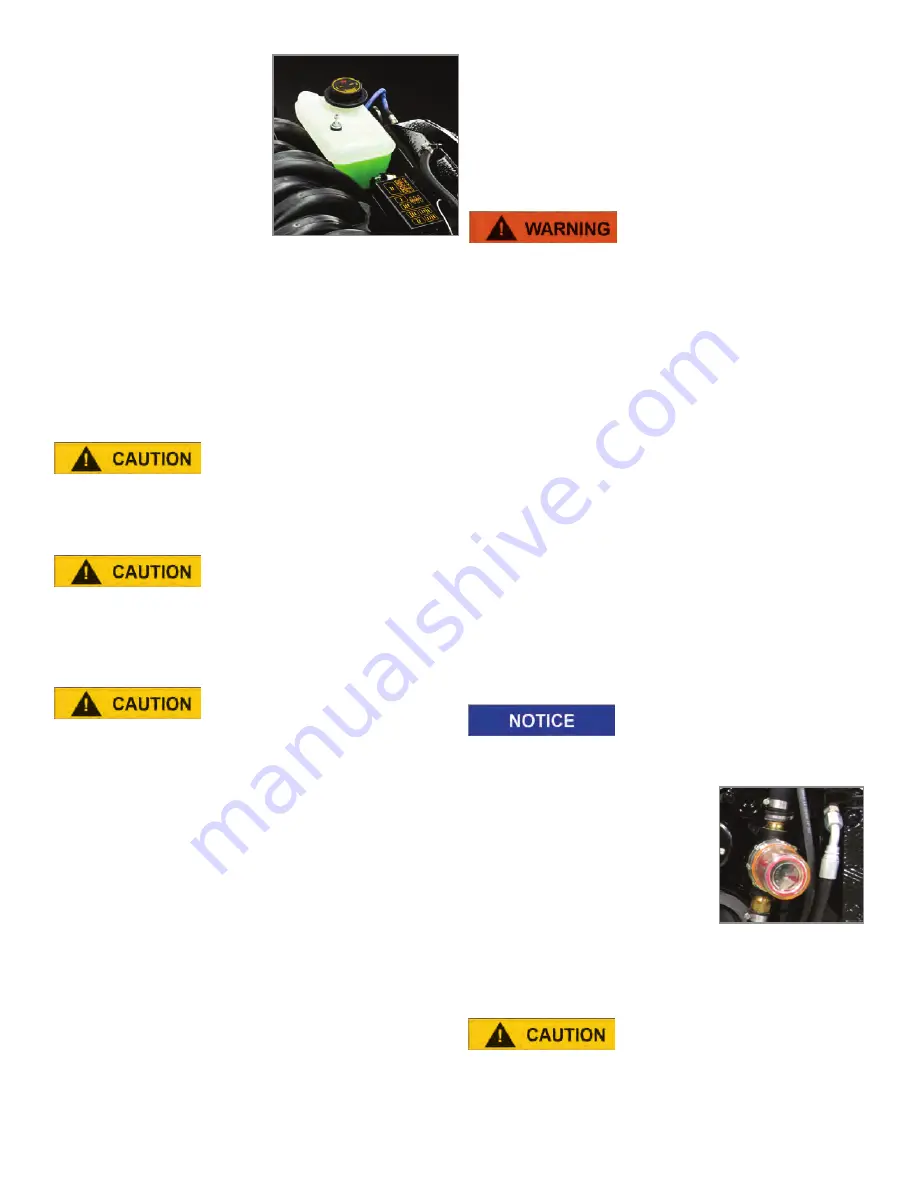
Cooling System
All Malibu Monsoon Engines
feature a hybrid of raw water
cooling and closed cooling.
Peak
Sierra Brand, 5-year, 100,000-mile,
Marine Grade Coolant (propylene
glycol) in a 50/50 mix with distilled
water is strongly recommended.
From an empty tank to the
proper amount of coolant/water
mix will require approximately two
gallons. Directions for maintaining
proper levels are provided in the
Care and Maintenance section of
this manual.
Without the need for a radiator such as used by land-based
engines, the functionality of the cooling system is dependent upon
operation within a body of water or maintaining the appropriate
level of coolant/water in the system. Reducing operational heat
from the engine is critical to ensuring the engine continues to
perform. As Malibu Monsoon engines are configured, temperatures
in excess of 200
o
F (93
o
C) are considered to be overheating
situations.
NEVER run the boat engine with the
boat out of a body of water! Even in
closed cooling systems, some external
water is used in the cooling process. Without water to circulate
in the system, the engine will quickly overheat and can cause
permanent damage that is not covered under warranty!
Be certain to read the Care and
Maintenance section of this manual for
important information regard routine
and regular functions that must be performed. Some of these tasks
overlap engine and boat component attention and should never
be skipped. Failure to perform care and maintenance can result in
damage to the boat and engine that is not covered under warranty.
Regularly review the engine
temperature information provided on
gauges or video screen. Warning lights
and alarms also are part of the system to provide early warning
when engine temperatures begin to exceed acceptable levels.
Continuing to operate a boat that is overheating the engine and
powertrain will result in engine failure eventually. Ignoring or
failing to take proper steps to reduce the engine temperature,
resulting in damage, is not covered under the warranty.
If an engine overheats, consider several factors before shutting
down.
(Turning off the engine when it is overheated may not provide
immediate relief, and in some instances can actually cause additional
harm.)
If the boat has been idling for a prolonged period of time and the
engine became overheated, attempt to reduce the temperature by
operating the boat at a higher speed, preferably at normal running
speed. This will increase the speed of water flowing through the
cooling system, assuming there is sufficient fluid.
If the boat has been running at a higher rate of speed for a
prolonged period of time and overheats, reduce speed for a few
minutes to see if the temperature reduces. Running at wide-
open-throttle (WOT) for too long can challenge the cooling
system.
If there is no immediately discernible cause for overheating, or if
the temperature does not begin to descend back to the normal range,
turn off the engine and carefully open the engine compartment
(but
never if there is an odor of fuel).
Ambient air should eventually
cool the engine, but if there is resulting damage to the engine from
overheating, it may not restart, and the boat may need to be towed to
shore.
Never directly touch an overheated
engine. Temperatures can exceed 200
0
Fahrenheit (93
0
Celsius), which would
cause instant and serious burns, even through gloves or clothing.
The water pumps on the engine that circulate water and coolant
throughout the engine during operation are essentially inaccessible
to the consumer. The circulation pump, which circulates coolant,
is located on the bottom of the front-end accessory drive. If it
requires attention, that should be done by a service technician at an
authorized Malibu dealership.
Another pump, the raw water intake pump, is utilized to bring in
water from the body of water. The raw-water pump is located on the
top of the front-end accessory drive, adjacent to the alternator. Its
purpose is to draw and circulate water from the body of water in which
the boat is operating to increase the cooling effect for the engine.
Water is brought through the raw water pickup, which is located at the
transom, next to the steering tiller arm. The entire cooling system is
located on the front of the engine on the transom side.
As part of the routine annual maintenance, the raw water pump
should be inspected, with particular attention to the impeller. The
process for inspection is explained in the
Care and Maintenance
section of this manual.
If the boat is operated in shallow or brackish
water, or if the boat is run aground, the impeller should be checked
regularly. Silt, sand, dirt and weeds can accelerate the deterioration
of the impeller.
Malibu boats are equipped with a flush kit. The process for
properly using a flush kit is explained in the
Care and Maintenance
section of this manual.
Inspect that the flush cap is tight before
every outing or it will suck air and
could damage the cooling system. Such
damage is not covered under warranty.
Most often, the cause of overheating
is either marine growth clogging the raw
water intake or insufficient coolant/water.
If there is debris, even in small amounts,
in the body of water, during usage it is
likely that some of the marine growth can
accumulate in the cooling system.
To protect the system, a sea strainer
is installed near the raw water intake and
serves the purpose of keeping debris from
entering the cooling system, causing eventual engine failure. As with any
kind of strainer, it is necessary to regularly clean it so that water can flow
unimpeded.
Except for the sea strainer and raw
water impeller, consumers should
not attempt to inspect or repair
components of the cooling system. Most are inaccessible. All
can be inadvertently damaged if not properly accessed, often
necessitating specialized tools. Attempting unauthorized
inspection or repair can void the warranty.
84—Engines & Powertrains
















































